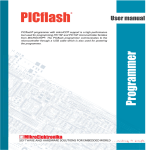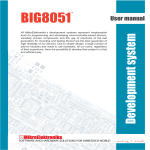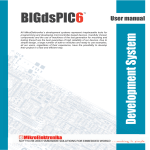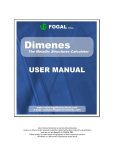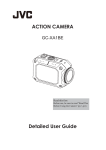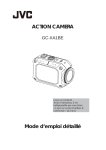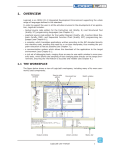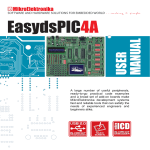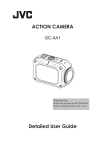Download mikroICD User Manual
Transcript
®
mikroICD
User manual
Debugger
mikroICD debugger is a highly effective tool for real-time debugging at
hardware level. It enables you to view program variable values, Special
Function Registers (SFRs) and EEPROM while the program is running.
This manual contains practical example on how to create a new project,
write and compile code and test the results.
TO OUR VALUED CUSTOMERS
, ZDQW WR H[SUHVV P\ WKDQNV WR \RX IRU EHLQJ LQWHUHVWHG LQ RXU SURGXFWV DQG IRU KDYLQJ FRQ¿GHQFH LQ
mikroElektronika.
The primary aim of our company is to design and produce high quality electronic products and to constantly
improve the performance thereof in order to better suit your needs.
Nebojsa Matic
General Manager
The Microchip® name and logo, PIC® and dsPIC® are registered trademarks of Microchip Technology Incorporated in the U.S.A. and
other countries. All other trademarks mentioned herein are property of their respective companies and are only used for the purpose of
LGHQWL¿FDWLRQRUH[SODQDWLRQDQGWRWKHRZQHU¶VEHQH¿WZLWKQRLQWHQWWRLQIULQJH
page
3
TABLE OF CONTENTS
1.0. mikroICD Overview............................................................................................................................ 4
Hardware..................................................................................................................................... 4
Software....................................................................................................................................... 5
2.0. Using mikroICD................................................................................................................................. 6
Writing the Program and Setting up the Project for Debugging................................................... 6
Compiling the Program and Dumping it into the Microcontroller................................................... 7
Starting up the mikroICD Debugger.............................................................................................. 8
3.0. Practical Example of Using mikroICD............................................................................................... 9
4.0. mikroICD Debugger Options.............................................................................................................13
Real-Time Debugging..................................................................................................................13
Breakpoints..................................................................................................................................13
Watch Window Option................................................................................................................. 14
Advanced Breakpoints Option..................................................................................................... 15
View Assembly Option................................................................................................................. 16
EEPROM Watch Window............................................................................................................ 16
RAM Window............................................................................................................................... 17
MikroElektronika
page
4
mikroICD Debugger
1.0. mikroICD® Overview
The mikroICD (In-Circuit Debugger) is a hardware tool designed for testing and debugging programs on most PIC microcontrollers. It also
enables you to monitor the state of all registers within the microcontroller which operates in real environment. In order for the mikroICD
debugger to be used, it is necessary to have the appropriate hardware as well as to install additional software.
Hardware
The mikroICD is an integral part of the 3,&ÀDVK programmer intended for use with PIC16, PIC18, PIC24, dsPIC30 and dsPIC33
microcontrollers. It is built into all PIC® development systems designed by MikroElektronika such as (DV\3,& (DV\3,&
%LJ3,&, EasydsPIC4, LV 24-33A etc. Thanks to mikroICD support, the 3,&ÀDVK® programmer is a multifunctional device as
it may be used for programming PIC microcontrollers as well as for debugging programs executed in real time. Besides, the
3,&ÀDVK programmer is also available as a stand-alone device used for programming chips built into (soldered on) the target device.
3,&ÀDVKSURJUDPPHUEXLOWLQWRWKH(DV\3,&
development system
PIC microcontrollers are connected to the programmer through the PGC, PGD and MCLR pins. In case that such programmer is used for
the programming only, its hardware will automatically break connection with these pins after loading the HEX code, thus enabling them to
be used for other purposes.
,QFDVHWKDWWKH3,&ÀDVKSURJUDPPHULVDOVRXVHGIRUGHEXJJLQJPLNUR,&'LVHQDEOHGWKHVHSLQVZLOOEHXVHGIRUFRPPXQLFDWLRQZLWK
the PC and cannot be used for other purposes.
MikroElektronika
The process of testing and debugging programs in real environment is performed by monitoring the state of all registers within the
microcontroller. The mikroICD debugger also offers functions such as running a program step by step (single stepping), pausing the
program execution to examine the state of currently active registers using breakpoints, tracking the values of some variables etc. In
this case the mikroICD debugger is connected to the PC all the time so that the PGC, PGD and MCLR/Vpp pins cannot be used for the
operation of the target device.
page
5
mikroICD Debugger
Software
The mikroICD debugger needs the additional software to be installed on the PC for its operation. Such software includes:
3,&ÀDVK Y (or later version) is a program used along with the 3,&ÀDVK programmer’s hardware. It enables you to select the
microcontroller to be programmed and to set up its mode. You can download it for free from our website at www.mikroe.com.
'ULYHUV necessary for the proper operation of the 3,&ÀDVK programmer enable communication between the PC and the 3,&ÀDVK
programmer’s hardware.
CompilersDUHSURJUDPVXVHGIRUFRPSLOLQJSURJUDPVZULWWHQLQKLJKOHYHOSURJUDPPLQJODQJXDJHVLQWRH[HFXWDEOH¿OH+(;FRGH+HUH
is a list of compilers providing the mikroICD support:
mikroC PRO® 2009;
mikroBasic PRO® 2009;
mikroPascal PRO® 2009;
mikroC® (dsPIC30/33 & PIC24);
mikroBasic® (dsPIC30/33 & PIC24); and
mikroPascal® (dsPIC30/33 & PIC24).
The compilers’ demo versions can be downloaded for free from our website atZZZPLNURHFRP
MikroElektronika
page
6
mikroICD Debugger
2.0. Using mikroICD
The PLNUR,&'debugger comes with all PIC and dsPIC compilers designed by MikroElektronika. This manual illustrates and describes its
operation in thePLNUR&352IRU3,& compiler. The principle of the operation is the same for PLNUR%DVLF and PLNUR3DVFDO compilers as well.
Step 1: Writing the Program and Setting up the Project for Debugging
&UHDWLQJDQHZSURMHFWDQGZULWLQJDSURJUDPLQWKHFRPSLOHU¶VPDLQZLQGRZVKRXOGEHGRQH¿UVW7KHQH[WVWHSLVWRVHWXSWKHSURMHFWIRU
debugging using the mikroICD debugger. To perform this, it is necessary to select the following options in the 3URMHFW6HWWLQJVwindow:
Select the ,&' 'HEXJ option to
enable the process of debugging.
mikroC PRO for PIC main window
Select the mikroICD option to
enable the PLNUR,&'debugger
to be used for debugging.
MikroElektronika
7
page
mikroICD Debugger
Step 2: Compiling the Program and Dumping It into the Microcontroller
The program has to be compiled into the machine code before it is downloaded into the microcontroller. In order to start the process of
compiling, click one of the appropriate shortcut icons or select the following option from the compiler’s Project drop-down menu:
%XLOG3URJUDP [Ctrl+F11]
By clicking on this command, the 3,&ÀDVK programmer will be automatically activated after completing the process of compiling and the
compiled program (HEX code) will be immediately loaded into the microcontroller’s program memory. The programming progress will be
shown in the 3,&ÀDVK programmer’s window to appear on the screen:
Project drop-down menu - Build options
3,&ÀDVK programmer’s main window
NOTE: In addition to the aforementioned build option which causes the program to be automatically compiled and loaded into the
microcontroller memory, there are two other build options in the Project drop-down menu:
%XLOG>&WUO)@
%XLOG$OO [Shift+F9]
,IWKHSURMHFWFRQVLVWVRIRQH¿OHDQG
,IWKHSURMHFWFRQVLVWVRIVHYHUDO¿OHV
These options are intended for compiling only and do not start up the programming process. Accordingly, when these are used, the HEX
FRGHKDVWREHORDGHGLQWRWKHPLFURFRQWUROOHUIURPZLWKLQWKH3,&ÀDVKSURJUDPXVLQJWKH/RDG and:ULWHoptions. More information on
0&8SURJUDPPLQJXVLQJWKH3,&ÀDVKSURJUDPPD\EHIRXQGLQWKH3,&ÀDVK3URJUDPPHU manual.
MikroElektronika
page
8
mikroICD Debugger
Step 3: Starting up the mikroICD Debugger
After the microcontroller has been successfully programmed, it is time to start up the mikroICD by selecting the 6WDUW'HEXJJHU option
from the 5XQ drop-down menu.
Start Debugger option
As mentioned before, the mikroICD debugger enables you to directly monitor the state of all registers within the microcontroller. Some of
the most frequently used debugger options are: 6WHS,QWR6WHS2YHU5XQWR&XUVRUand 6WHS2XW. For the :DWFK9DOXHV window to appear
on the screen, select the 9LHZ!'HEXJ:LQGRZV!:DWFK:LQGRZoption.
Icon commands
Click on some of these options to
add/remove selected registers on the list
A complete list of registers within
the programmed microcontroller
A list of selected registers to be monitored.
The state of these registers change
during the program execution, which can
be viewed in this window
Double click on the 9DOXH¿HOGHQDEOHV
you to change data format
The :DWFK 9DOXHV window showing the state of the
microcontroller’s registers and program variables
MikroElektronika
9
page
mikroICD Debugger
3.0. Practical Example of Using mikroICD
Here is a step-by-step illustration of the operation of the mikroICD:
Step 1: Writing the Program and Setting up the Project for ICD Debugging
Program Example
/* Here is a simple program to demonstrate the operation of the microcontroller. The PORTC port’s
SLQVDUHFRQ¿JXUHGDVGLJLWDORXWSXWVDQGWKHLUORJLFVWDWHFKDQJHVRQFHSHUVHFRQG(VWDEOLVKLQJ
FRQQHFWLRQEHWZHHQVXFKSRUWDQG/('VZLOOFDXVH/('VWREOLQNVLPXOWDQHRXVO\
void main() {
TRISC = 0x00;
PORTC = 0x00;
&RQ¿JXUH3257&SLQVDVRXWSXWV
7XUQ2))/('VRQ3257&
do {
3257& [))7XUQ21/('VRQ3257&
'HOD\BPVVHFRQGGHOD\
PORTC = 0x00;
7XUQ2))/('VRQ3257&
'HOD\BPVVHFRQGGHOD\
`ZKLOH(QGOHVVORRS
}
When the program has been written, it is necessary to select the appropriate debugging mode before it is compiled into the HEX code, in
order to perform debugging using the mikroICD debugger.
First, to debug program, select the ,&''HEXJ option from the 3URMHFW6HWWLQJV window.
Then, select the mikroICD option to enable the PLNUR,&'debugger to be used for debugging.
MikroElektronika
page
10
mikroICD Debugger
Step 2: Compiling the Program and Dumping It into the Microcontroller
In order to compile the program into the HEX code and automatically dump it into the microcontroller, select the %XLOGSURJUDPoption
[Ctrl+F11] from the3URMHFWdrop-down menu.
,PPHGLDWHO\DIWHUFRPSOHWLQJWKHFRPSLOLQJSURFHVVWKH3,&ÀDVKSURJUDPPHU¶VZLQGRZZLOODSSHDURQWKHVFUHHQ,QWKHULJKWERWWRPFRUQHU
thereof, there is the 3URJUHVV bar showing the programming progress. If the 7RROV!2SWLRQV!7RROV!3,&ÀDVK2SWLRQV!&ORVHZKHQ¿QLVKHG
RSWLRQLVWLFNHGRIIWKH3,&ÀDVKSURJUDPPHU¶VZLQGRZZLOOEHDXWRPDWLFDOO\FORVHGDIWHUSURJUDPPLQJ
3,&ÀDVKSURJUDPPHU¶VPDLQZLQGRZ
MikroElektronika
11
page
mikroICD Debugger
Step 3: Starting up mikroICD and Line-by-Line Program Execution
When the program is loaded into the microcontroller, its execution in real time can be monitored by using thePLNUR,&' debugger. To start
it up, select the 6WDUW'HEXJJHU option from the 5XQ drop-down menu or click the[F9] button.
Now, the program within the microcontroller will be executed line by line by pressing the [F8]button.
During program execution, the program line to be
next executed is highlighted in blue by default
Only two registers are selected here to be
monitored. Use the $GG $OO option to add all
registers within the microcontroller to the list of
selected registers to be monitored.
MikroElektronika
page
12
mikroICD Debugger
The :DWFK9DOXHV window enables you to monitor the state of selected registers and to view how their states change during program
execution.
,QWKLVH[DPSOHWKH¿UVWLQVWUXFWLRQLVH[HFXWHGXVLQJWKH6WHS2YHUoption. In higher programming languages such option executes the
whole program line regardless of how many assembly instructions it consists of.
6WHS2YHU
Command
The most recent state of registers is highlighted in red
By executing the same instruction (6WHS2YHU [F8]) two more times, the 32nd program line which contains the Delay_ms(1000) command
will be reached. To perform its execution, it is advisable to use the 5XQWR&XUVRU [F4] option as it executes the program at full speed.
The 5XQWR&XUVRU command will cause the program to
be executed at full speed until it encountes the program
line with cursor placed.
5XQWR&XUVRU
Command
MikroElektronika
13
page
mikroICD Debugger
4.0. mikroICD Debugger Options for Advanced Users
The following text describes the advanced options offered by the PLNUR,&'debugger.
Real-Time Debugging
The 6WHS,QWR>)@and 6WHS2YHU>)@ commands enable the program to be executed line by line. Program execution is a slow process in this
case, and as such, is suitable for short programs. Unlike them, the 5XQ3DXVH'HEXJJHU>)@and 5XQ7R&XUVRU>)@ commands enable
the program to be executed in real time and therefore be much faster. The speed of program execution depends on the microcontroller’s
own clock. By pressing [F6] or selecting the 5XQ3DXVH 'HEXJJHU option, the mikroICD is temporarily halted and the microcontroller
executes the loaded program at full speed. Another pressure on the same button reactivates thePLNUR,&' and the program execution
stops at reached location. By pressing [F4], the microcontroller will proceed with program execution at high speed until it reaches the line
selected by the cursor.
Breakpoints
ThePLNUR,&' enables each program line to be marked with a breakpoint. The breakpoint is an intentional stopping or pausing place in the
program used for the purpose of debugging. Breakpoints are placed in the program by clicking the space to the left of the program line or
by pressing [F5]. By selecting the5XQ command [F6], the microcontroller will execute the program from the current location (highlighted
in blue) until it reaches a breakpoint (highlighted in red). The debugger halts after reaching the breakpoint.
There are two kinds of breakpoints - hardware and software breakpoints. The only visible difference between them is in the speed of
SURJUDP H[HFXWLRQ EHIRUH LW UHDFKHV WKH VSHFL¿HG SURJUDP OLQH +DUGZDUH EUHDNSRLQWV DUH SODFHG ZLWKLQ WKH PLFURFRQWUROOHU FKLS DQG
provide considerably faster program execution. The number of hardware breakpoints is limited, whereas the total number of software
breakpoints is unlimited. For example, 16-bit PIC microcontrollers have only one, whereas 18-bit PIC microcontrollers have up to 3
hardware breakpoints. When all hardware breakpoints are used, then remaining breakpoints in the program will be used as software
breakpoints.
Click here to convert program line into breakpoint
MikroElektronika
page
14
mikroICD Debugger
Watch Window Option
The :DWFK:LQGRZ option allows you to monitor the values of program variables as well as the contents of SFRs while the program is
running. As soon as the program is loaded into the microcontroller, the :DWFK 9DOXHV window appears on the screen. To reopen this
window, when removed, select the option 9LHZ!'HEXJ:LQGRZV!:DWFK:LQGRZ.
Watch Window option
The :DWFK9DOXHV window displays data in three columns: register or variable names, their
values and memory addresses. Double click on any variable opens the (GLW9DOXH window
which allows you to assign it a new value. It is also possible to change data format (decimal,
KH[DGHFLPDOELQDU\ÀRDWLQJRUFKDUDFWHULQWKLVZLQGRZ
Edit Value window
Step Into [F7]
Stop Debugger
Step Over [F8]
Run to Cursor [F4]
Step Out [Ctrl+F8]
Toggle Breakpoint [F5]
Show/Hide Breakpoints Shift + [F4]
Run/Pause Debugger
Start Debugger
Clear Breakpoints Shift +Ctrl + F5]
Add selected variable
to the list
Remove all variables from the list
Remove selected
variable from the list
Add all variables to the list
Advanced Breakpoints option
Selected variable
MikroElektronika
Change format of the selected variable
15
page
mikroICD Debugger
Advanced Breakpoints Option
The mikroICD provides the means for using the $GYDQFHG%UHDNSRLQWV option with PIC18 and PIC18FJ microcontrollers. To enable it, tick
the $GYDQFHG%UHDNSRLQWV checkbox within the :DWFK9DOXHVZLQGRZ7RFRQ¿JXUHWKH$GYDQFHG%UHDNSRLQWV option it is necessary to
start up mikroICD [F9] and select the9LHZ¾'HEXJ:LQGRZV¾$GYDQFHG%UHDNSRLQWV option or to use the[Ctrl+Shift+A] shortcut icon.
Program Memory Break Option
The 3URJUDP0HPRU\%UHDNRSWLRQLVXVHGIRUSODFLQJEUHDNSRLQWVDWVSHFL¿HGDGGUHVVHVLQWKHSURJUDPPHPRU\7KHYDOXHHQWHUHGLQ
the $GGUHVV¿HOGPXVWEHLQWKHKH[IRUPDW
File Register Break Option
The )LOH5HJLVWHU%UHDNRSWLRQLVXVHGIRUVWRSSLQJFRGHH[HFXWLRQZKHQUHDGZULWHDFFHVVWRWKHVSHFL¿HGGDWDPHPRU\ORFDWLRQRFFXUV
If the 5HDG$FFHVV option is selected, the )LOH5HJLVWHU(TXDOoption can be used for setting the appropriate value in the 9DOXH¿HOG7KH
SURJUDPH[HFXWLRQZLOOEHVWRSSHGZKHQWKHYDOXHUHDGIURPWKHVSHFL¿HGGDWDPHPRU\ORFDWLRQPDWFKHVWKHYDOXHZULWWHQLQWKH9DOXH
¿HOG$OOWKHYDOXHVHQWHUHGLQWKH9DOXH¿HOGPXVWEHLQWKHKH[IRUPDW
When the $GYDQFHG %UHDNSRLQWV option is enabled, mikroICD operates in real-time mode, thus supporting only the following set of
FRPPDQGV6WDUW'HEXJJHU>)@5XQ3DXVH'HEXJJHU>)@DQG6WRS'HEXJJHU>&WUO)@$IWHUUHDFKLQJWKH¿UVWEUHDNSRLQWWKH$GYDQFHG
%UHDNSRLQWV option can be disabled and the process of debugging can be continued with a full set of commands. The number of advanced
breakpoints is equal to the number of hardware breakpoints and depends on the microcontroller in use.
MikroElektronika
page
16
mikroICD Debugger
View Assembly Option
During the process of compiling, each program line written in a high-level programming language is replaced with one or more assembly
instructions. To display program in the assembly language, select the 9LHZ$VVHPEO\option from the3URMHFWdrop-down menu. In this case,
the process of simulating and debugging is performed in the same way as if the program is written in a high-level programming language.
Program written
in the high level
programming
language...
...the same program compiled in the assembly language
EEPROM Watch Window
The ((3520 :DWFK window will appear by selecting the 9LHZ ¾ 'HEXJ :LQGRZV ! ((3520 :LQGRZ option. It shows the values
currently stored in the PIC internal EEPROM memory.
Pressing the :ULWH ((3520 button causes data from
the ((3520 :DWFK window to be loaded into internal
EEPROM memory of the microcontroller.
Pressing the 5HDG ((3520 button causes the
contents of the EEPROM memory to be read and
shown in the ((3520:DWFKZLQGRZ.
EEPROM Watch window
MikroElektronika
17
page
mikroICD Debugger
RAM Window
The mikroICD allows you to view the contents of the microcontroller’s RAM memory in the 5$0 window by clicking the 9LHZ!'HEXJ
:LQGRZV!5$0:LQGRZ option. Unlike the :DWFK:LQGRZ option, all memory locations are displayed in a table. The content of each
RAM location is displayed in the hexadecimal format and may be changed at any time during the operation of the microcontroller. Changed
values are directly written into the microcontroller by clicking (QWHU.
RAM window
MikroElektronika
18
page
mikroICD Debugger
Here is a list of the most frequently used PLNUR,&'options:
1DPH
6WDUW'HEXJJHU
5XQ3DXVH
'HEXJJHU
6WRS'HEXJJHU
6WHS,QWR
6WHS2YHU
6WHS2XW
5XQ7R&XUVRU
7RJJOH
%UHDNSRLQW
6KRZ+LGH
%UHDNSRLQWV
&OHDU%UHDNSRLQWV
MikroElektronika
'HVFULSWLRQ
)XQFWLRQNH\
6WDUWXSGHEXJJHU
>)@
5XQRUSDXVHGHEXJJHU
>)@
6WRSGHEXJJHU
([HFXWH WKH FXUUHQW SURJUDP OLQH WKHQ KDOWV ,I WKH SURJUDP OLQH H[HFXWHG
FDOOV DQRWKHU URXWLQH WKH GHEXJJHU VWHSV LQWR WKH URXWLQH DQG KDOWV DIWHU
H[HFXWLQJWKHILUVWLQVWUXFWLRQZLWKLQLW
([HFXWH WKH FXUUHQW SURJUDP OLQH WKHQ KDOWV ,I WKH SURJUDP OLQH H[HFXWHG
FDOOV DQRWKHU URXWLQH WKH GHEXJJHU ZLOO QRW VWHS LQWR LW 7KH ZKROH URXWLQH
ZLOOEHH[HFXWHGDQGWKHGHEXJJHUKDOWVDWWKHILUVWLQVWUXFWLRQIROORZLQJWKH
FDOO
([HFXWH DOO UHPDLQLQJ SURJUDP OLQHV ZLWKLQ WKH VXEURXWLQH 7KH GHEXJJHU
KDOWV LPPHGLDWHO\ XSRQ H[LWLQJ WKH VXEURXWLQH 7KLV RSWLRQ LV SURYLGHG ZLWK
WKH 3,& PLFURFRQWUROOHU IDPLO\ EXW QRW ZLWK WKH 3,& PLFURFRQWUROOHU
IDPLO\
([HFXWHWKHSURJUDPXQWLOUHDFKLQJWKHFXUVRUSRVLWLRQ
'XULQJ WKH SURFHVV RI GHEXJJLQJ WKH SURJUDP H[HFXWHV XQWLO UHDFKLQJ D
EUHDNSRLQW 7KH 7RRJOH %UHDNSRLQWV RSWLRQ VHWV QHZ EUHDNSRLQWV RU
UHPRYHVWKRVHDOUHDG\VHWDWWKHFXUUHQWFXUVRUSRVLWLRQ
7R YLHZ DOO WKH EUHDNSRLQWV LQ WKH SURJUDP VHOHFW WKH 6KRZ+LGH
%UHDNSRLQWV RSWLRQ IURP WKH 5XQ GURSGRZQ PHQX RU XVH WKH 6KLIW )
VKRUWFXW'RXEOHFOLFNDEUHDNSRLQWIURPWKHOLVWWRORFDWHLW
&OHDUDOOEUHDNSRLQWVIURPWKHSURJUDP
>&WUO)@
>)@
>)@
>&WUO)@
>)@
>)@
>6KLIW)@
>&WUO6KLIW)@
DISCLAIMER
All the products owned by MikroElektronika are protected by copyright law and international copyright treaty.
Therefore, this manual is to be treated as any other copyright material. No part of this manual, including product
and software described herein, may be reproduced, stored in a retrieval system, translated or transmitted in
any form or by any means, without the prior written permission of MikroElektronika. The manual PDF edition
FDQEHSULQWHGIRUSULYDWHRUORFDOXVHEXWQRWIRUGLVWULEXWLRQ$Q\PRGL¿FDWLRQRIWKLVPDQXDOLVSURKLELWHG
0LNUR(OHNWURQLND SURYLGHV WKLV PDQXDO µDV LV¶ ZLWKRXW ZDUUDQW\ RI DQ\ NLQG HLWKHU H[SUHVVHG RU LPSOLHG
LQFOXGLQJEXWQRWOLPLWHGWRWKHLPSOLHGZDUUDQWLHVRUFRQGLWLRQVRIPHUFKDQWDELOLW\RU¿WQHVVIRUDSDUWLFXODU
purpose.
MikroElektronika shall assume no responsibility or liability for any errors, omissions and inaccuracies that may
DSSHDULQWKLVPDQXDO,QQRHYHQWVKDOO0LNUR(OHNWURQLNDLWVGLUHFWRUVRI¿FHUVHPSOR\HHVRUGLVWULEXWRUVEH
OLDEOHIRUDQ\LQGLUHFWVSHFL¿FLQFLGHQWDORUFRQVHTXHQWLDOGDPDJHVLQFOXGLQJGDPDJHVIRUORVVRIEXVLQHVV
SUR¿WVDQGEXVLQHVVLQIRUPDWLRQEXVLQHVVLQWHUUXSWLRQRUDQ\RWKHUSHFXQLDU\ORVVDULVLQJRXWRIWKHXVH
of this manual or product, even if MikroElektronika has been advised of the possibility of such damages.
MikroElektronika reserves the right to change information contained in this manual at any time without prior
notice, if necessary.
HIGH RISK ACTIVITIES
The products of MikroElektronika are not fault–tolerant nor designed, manufactured or intended for use or
resale as on–line control equipment in hazardous environments requiring fail–safe performance, such as in
WKHRSHUDWLRQRIQXFOHDUIDFLOLWLHVDLUFUDIWQDYLJDWLRQRUFRPPXQLFDWLRQV\VWHPVDLUWUDI¿FFRQWUROGLUHFWOLIH
support machines or weapon systems in which the failure of Software could lead directly to death, personal
LQMXU\RUVHYHUHSK\VLFDORUHQYLURQPHQWDOGDPDJH³+LJK5LVN$FWLYLWLHV´0LNUR(OHNWURQLNDDQGLWVVXSSOLHUV
VSHFL¿FDOO\GLVFODLPDQ\H[SUHVVHGRULPSOLHGZDUUDQW\RI¿WQHVVIRU+LJK5LVN$FWLYLWLHV
Copyright 2003 – 2009 by MikroElektronika. All rights reserved.
,I\RXKDYHDQ\TXHVWLRQVFRPPHQWVRUEXVLQHVVSURSRVDOVGRQRWKHVLWDWHWRFRQWDFWXVDWRI¿FH#PLNURHFRP
If you are experiencing some problems with any of our products or just need additional information, please place your ticket at
www.mikroe.com/en/support
If you want to learn more about our products, please visit our website at www.mikroe.com




















